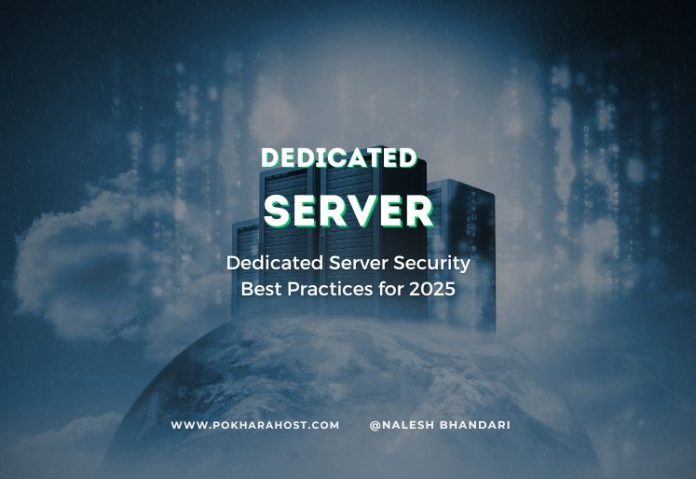Secure your dedicated server in 2025 with these expert best practices. Learn about firewall configurations, DDoS protection, encryption, and more for optimal web hosting security.
As cyber threats evolve, securing your dedicated server has never been more critical. Businesses relying on web hosting must adopt advanced security measures to protect sensitive data, prevent breaches, and ensure uninterrupted service.
In this guide, we’ll explore the top dedicated server security best practices for 2025, helping you safeguard your infrastructure against emerging threats. Whether you’re managing an e-commerce site, SaaS platform, or enterprise application, these strategies will enhance your security posture.
Why Dedicated Server Security Matters in 2025
Cyberattacks are becoming more sophisticated, with threats like:
- Ransomware attacks (encrypting data until a ransom is paid)
- DDoS attacks (overwhelming servers with traffic)
- Zero-day exploits (targeting unknown vulnerabilities)
- Brute force attacks (cracking passwords through trial and error)
A single breach can lead to:
✔ Data theft (customer information, financial records)
✔ Downtime & revenue loss
✔ Reputation damage
By implementing robust security measures, you can mitigate these risks and maintain a secure web hosting environment.
Top 10 Dedicated Server Security Best Practices for 2025
1. Use a Firewall & Intrusion Prevention System (IPS)
A firewall filters incoming/outgoing traffic, while an IPS detects and blocks malicious activity.
🔹 Best Practices:
- Configure hardware and software firewalls (e.g., CSF, iptables)
- Set default deny policies (only allow necessary ports)
- Enable real-time monitoring for suspicious traffic
2. Enable DDoS Protection
Distributed Denial-of-Service (DDoS) attacks can cripple your server.
🔹 Best Practices:
- Use cloud-based DDoS mitigation (e.g., Cloudflare, Akamai)
- Configure rate limiting to block excessive requests
- Deploy Anycast DNS to distribute traffic
3. Implement Strong Password Policies & Multi-Factor Authentication (MFA)
Weak passwords are a leading cause of breaches.
🔹 Best Practices:
- Enforce 12+ character passwords with symbols, numbers, and uppercase letters
- Use SSH key authentication instead of passwords where possible
- Enable MFA for all admin logins (Google Authenticator, Authy)
4. Regularly Update Software & Apply Security Patches
Outdated software is vulnerable to exploits.
🔹 Best Practices:
- Enable automatic security updates for OS and applications
- Schedule monthly vulnerability scans
- Remove unused software to reduce attack surfaces
5. Encrypt Data with SSL/TLS & Disk Encryption
Encryption prevents unauthorized access to sensitive data.
🔹 Best Practices:
- Install free SSL certificates (Let’s Encrypt) for websites
- Use LUKS or BitLocker for full disk encryption
- Enable TLS 1.3 for secure communications
6. Disable Unnecessary Services & Ports
Open ports and unused services increase exposure to attacks.
🔹 Best Practices:
- Run
netstat -tulnto check open ports - Disable Telnet, FTP, and insecure protocols (use SFTP/SSH instead)
- Close port 22 (SSH) if not in use or restrict IP access
7. Set Up Automated Backups & Disaster Recovery
Backups are your last line of defense against ransomware.
🔹 Best Practices:
- Follow the 3-2-1 backup rule (3 copies, 2 media types, 1 offsite)
- Use incremental backups to save storage space
- Test backup restoration quarterly
8. Monitor Server Logs & Set Up Alerts
Proactive monitoring helps detect breaches early.
🔹 Best Practices:
- Use SIEM tools (e.g., Splunk, Graylog) for log analysis
- Set up real-time alerts for failed login attempts
- Monitor CPU, RAM, and bandwidth spikes (possible DDoS signs)
9. Isolate Critical Services with Containerization
Running services in containers (Docker) or virtual machines (VMs) limits breach impact.
🔹 Best Practices:
- Use Docker/Kubernetes for application isolation
- Implement micro-segmentation to restrict lateral movement
- Run database servers on separate instances
10. Conduct Regular Security Audits & Penetration Testing
Simulating attacks helps uncover vulnerabilities.
🔹 Best Practices:
- Perform quarterly penetration tests
- Use Nmap, Metasploit, or Nessus for vulnerability scanning
- Hire ethical hackers for advanced security assessments
PokharaHost’s Secure Dedicated Server Solutions
At PokharaHost, we prioritize security for your web hosting needs. Our dedicated servers include:
✅ Enterprise-grade firewalls & DDoS protection
✅ Free SSL certificates & automated backups
✅ 24/7 server monitoring & malware scanning
✅ Compliance with GDPR & data protection laws
Upgrade to a secure dedicated server today!
Final Thoughts
Securing a dedicated server in 2025 requires a multi-layered approach—firewalls, encryption, monitoring, and proactive threat detection. By following these best practices, you can protect your web hosting infrastructure from evolving cyber threats.
Need help securing your server? Contact PokharaHost for managed security solutions tailored to your business.
